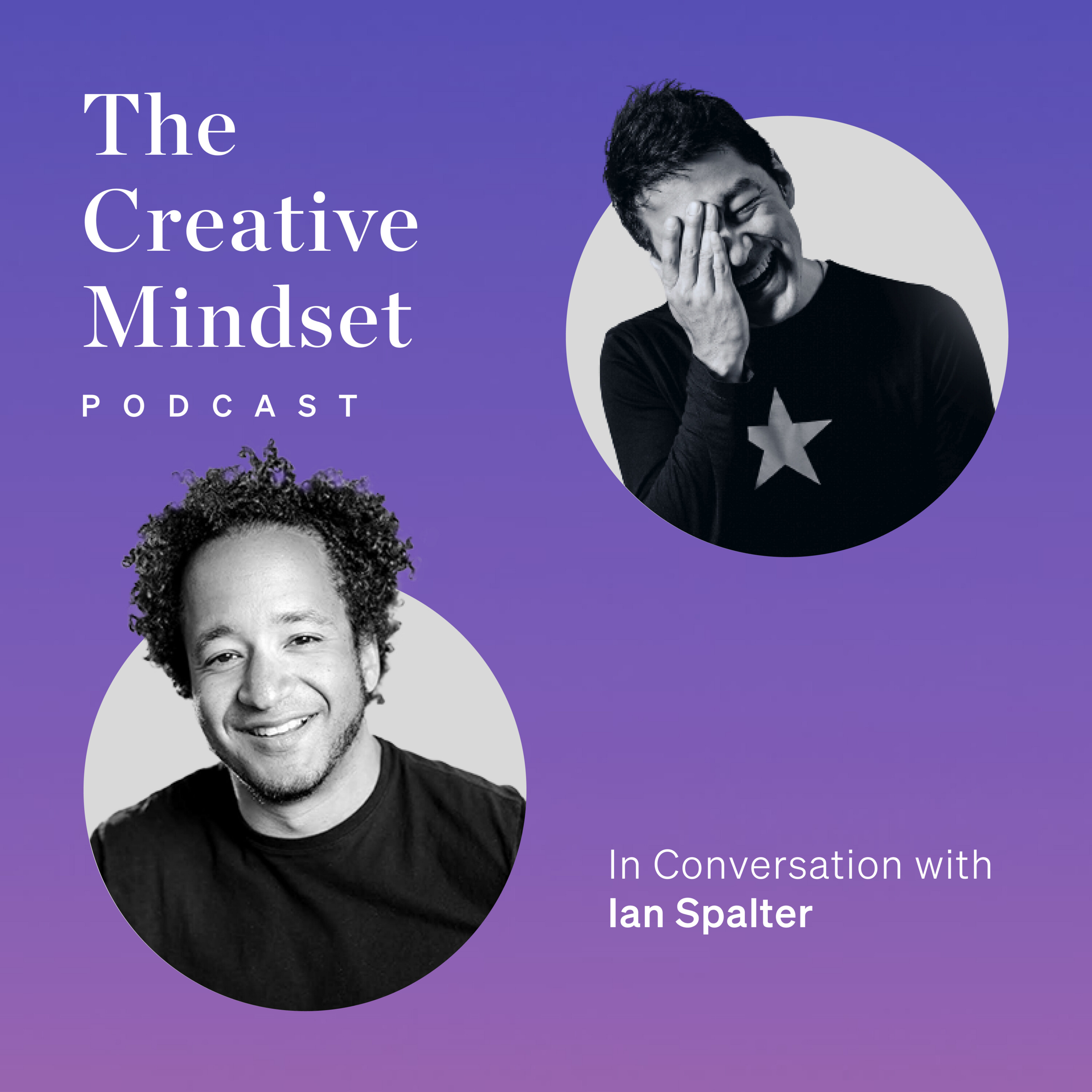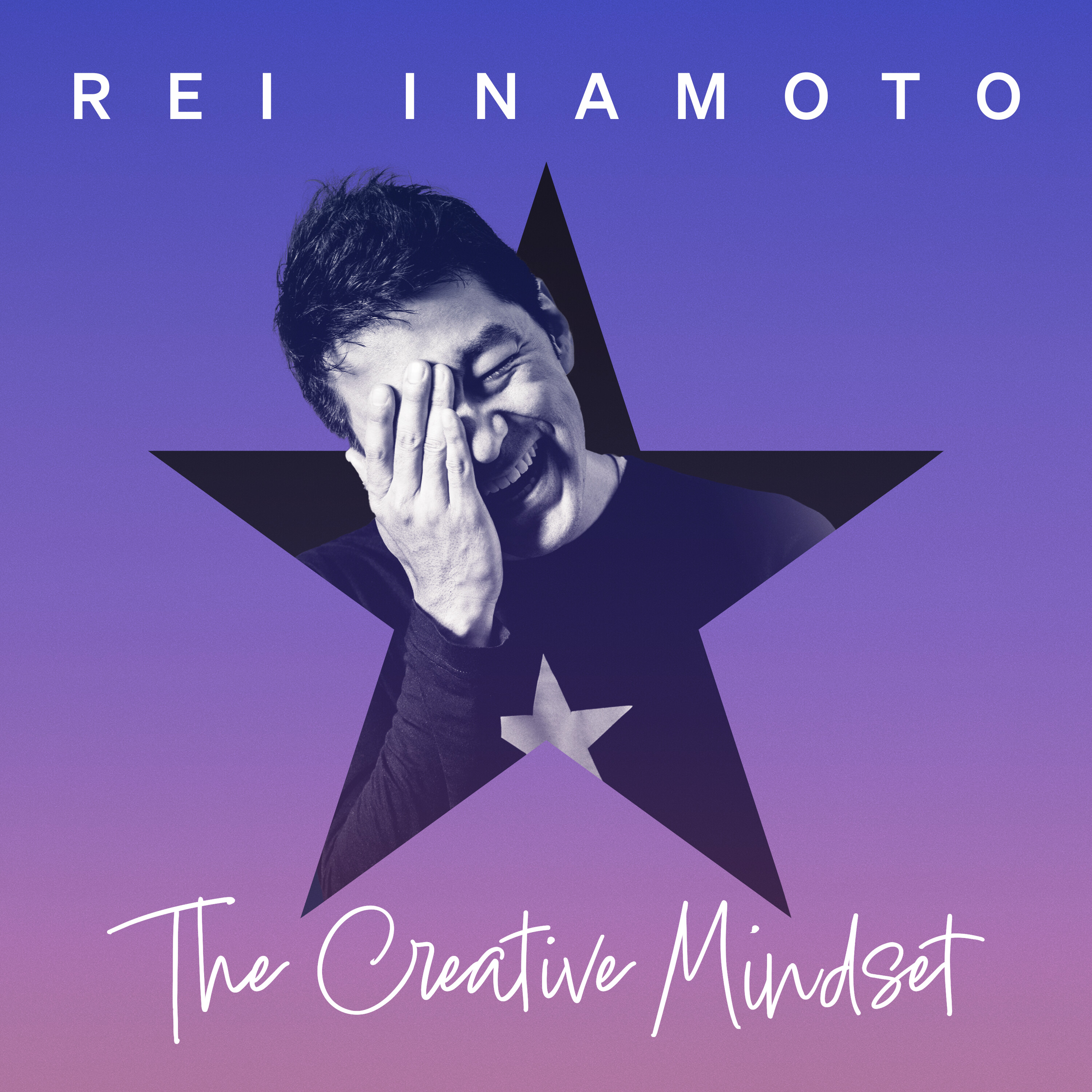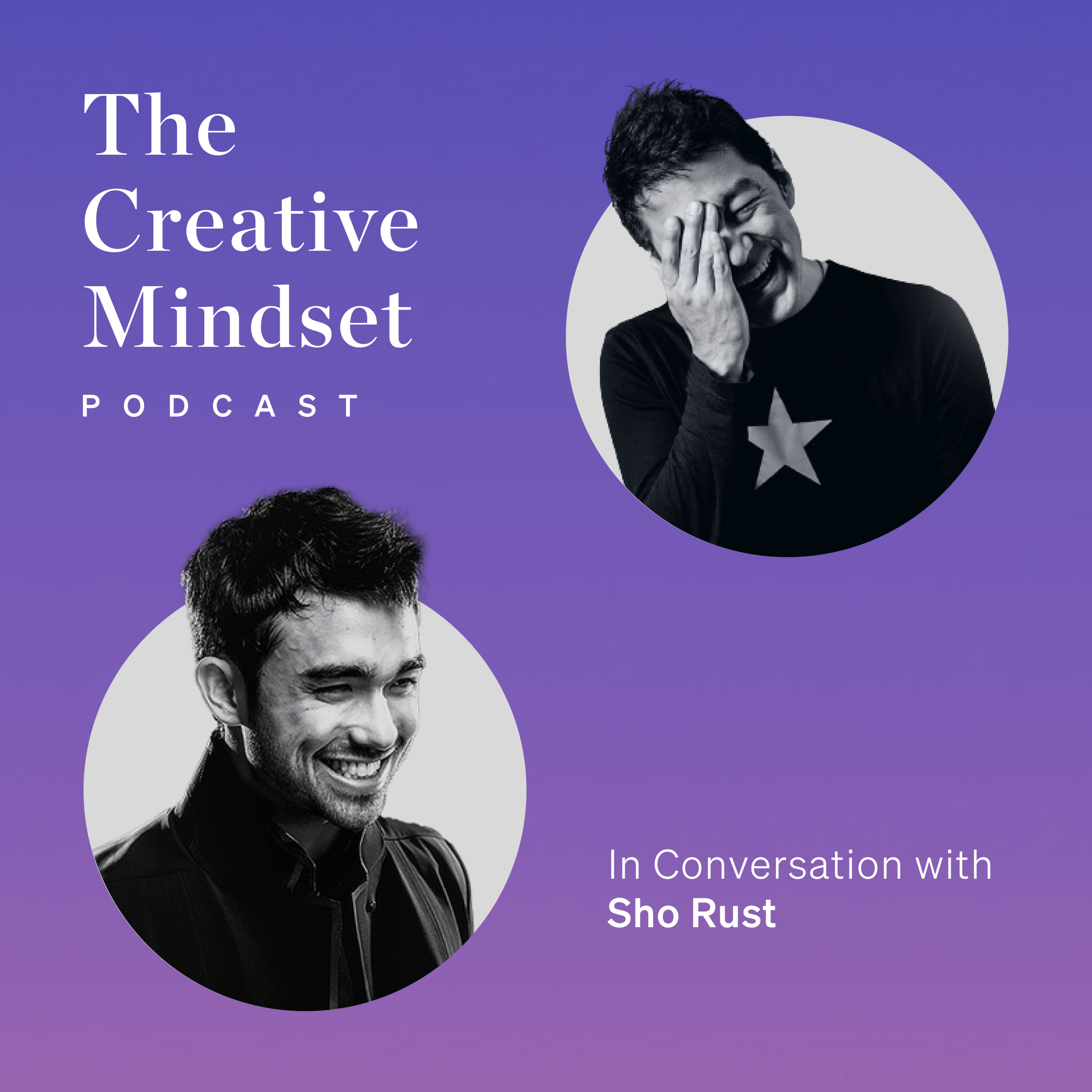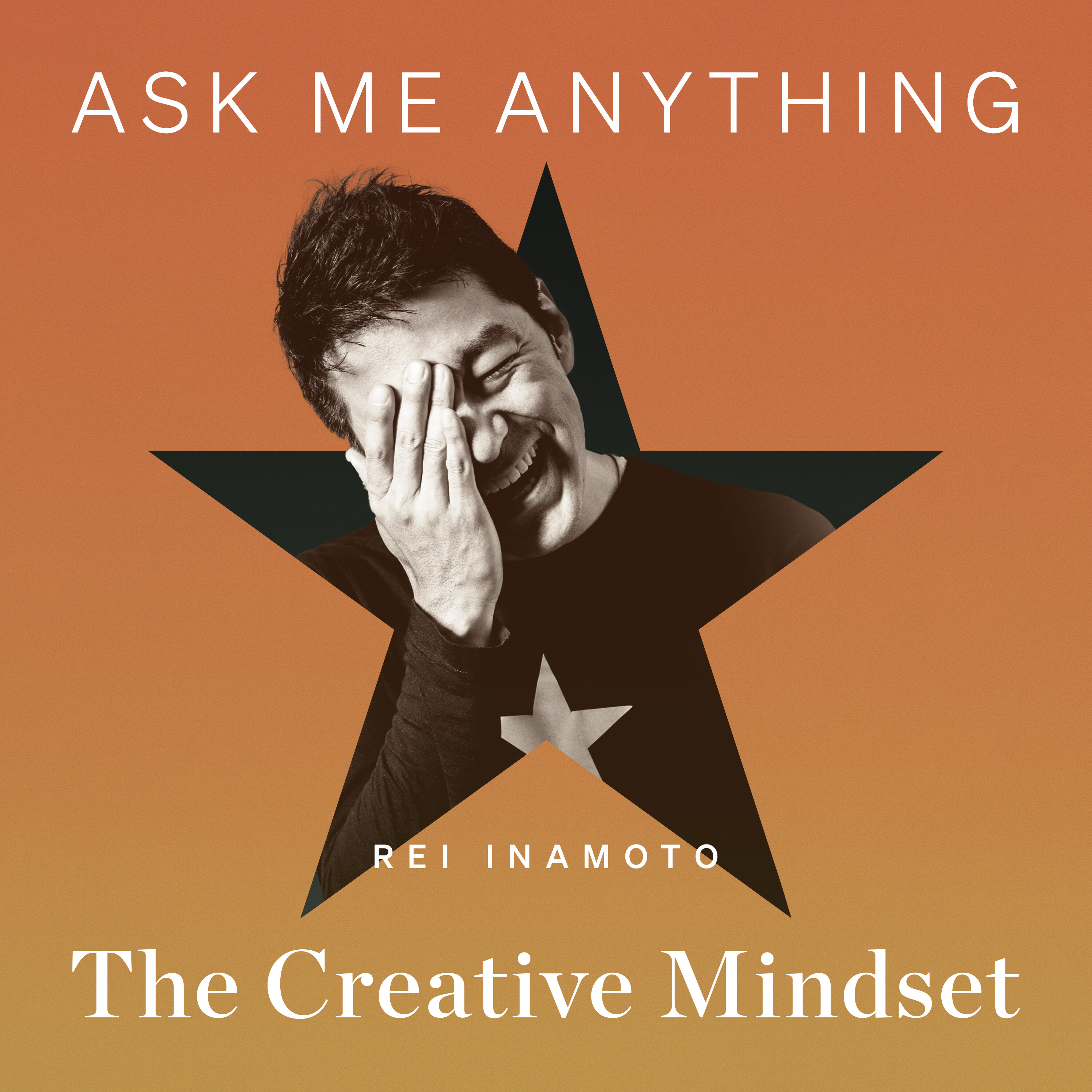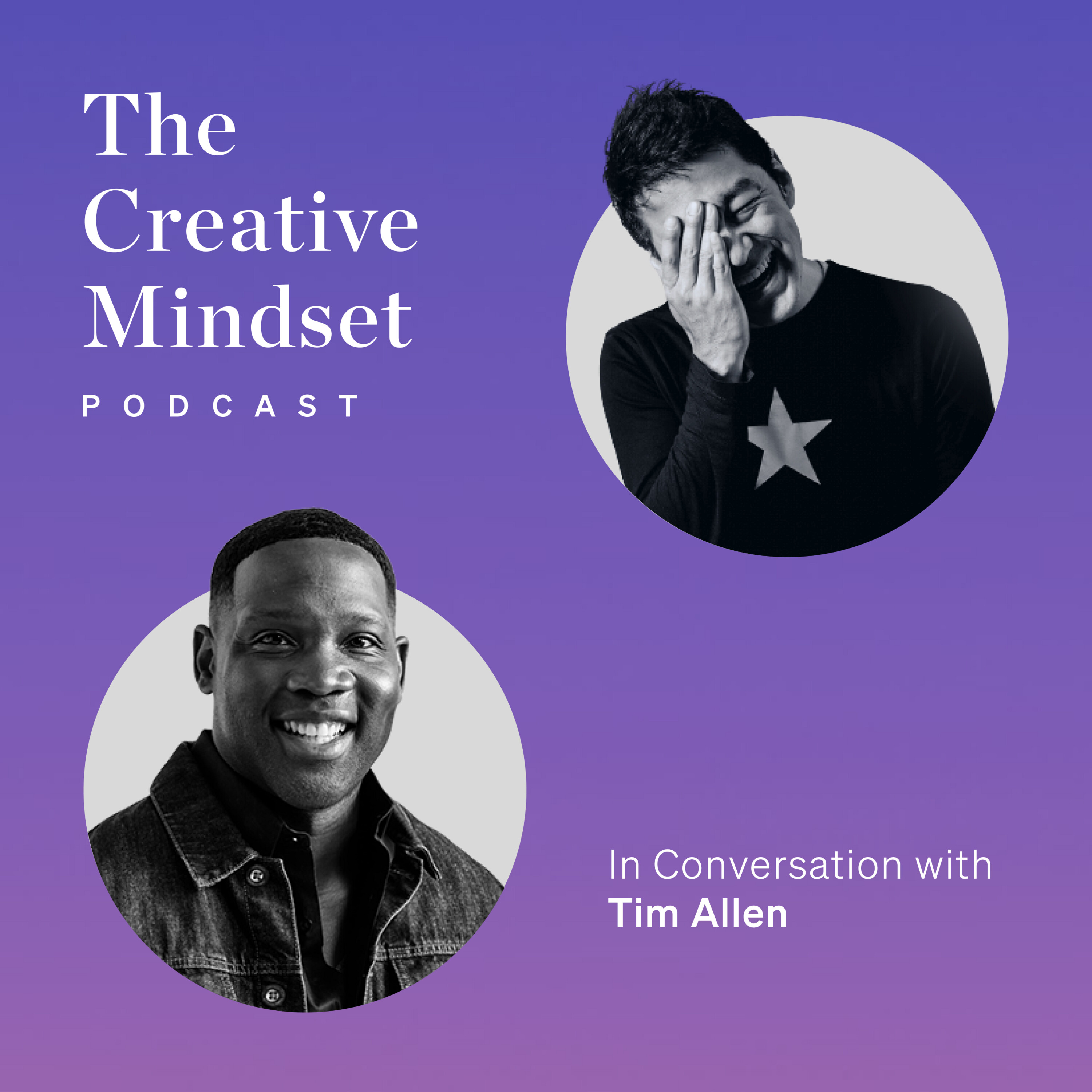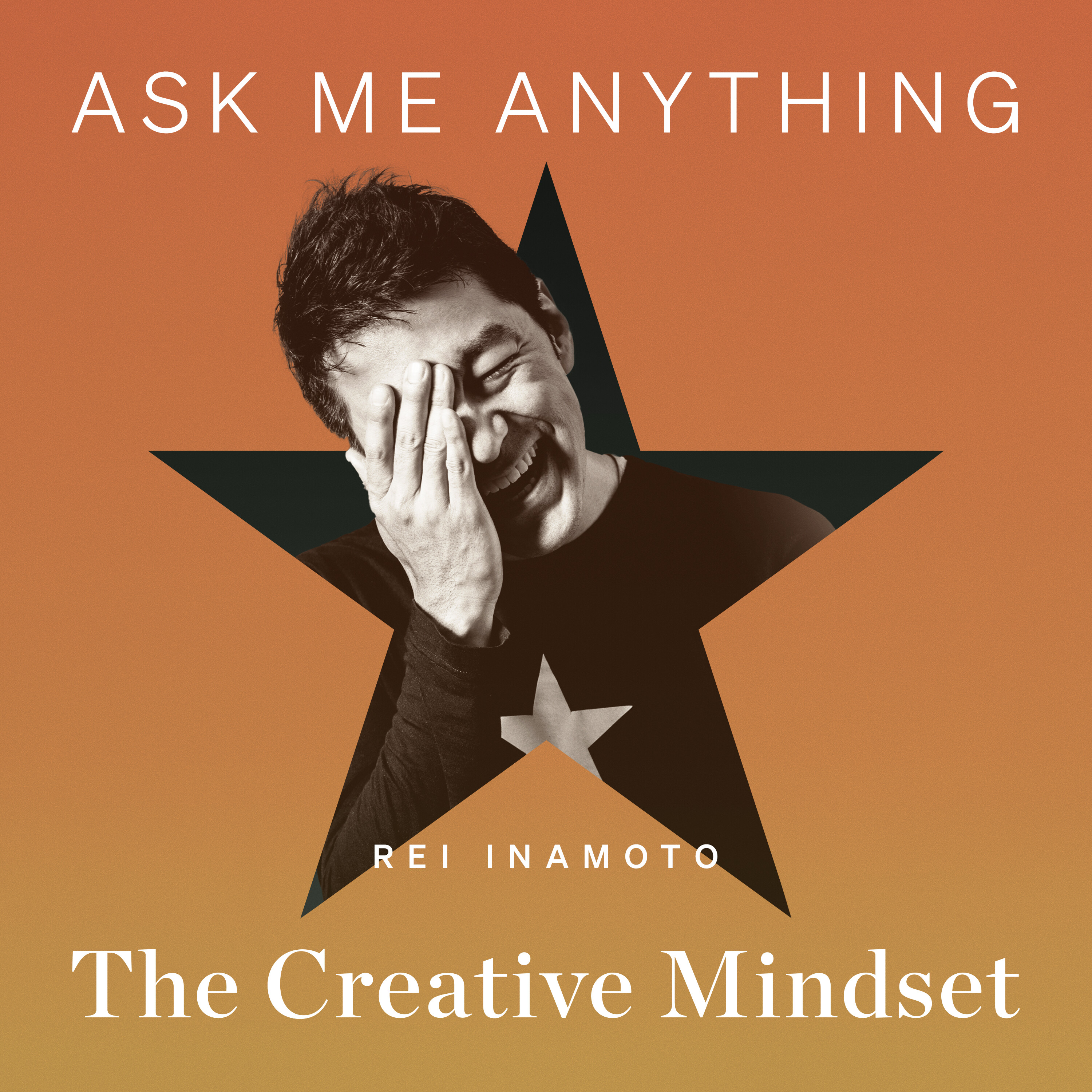This is ReinaMoto's Podcast. The Creative Mindset.
Hi, this is ReinaMoto. Welcome to The Creative Mindset, a podcast about building a creative
career through conversations with the world's best practitioners. We talk with artists, designers,
architects, curators, chefs, and other luminaries of diverse creative pursuits.
Just a little background about this podcast. We started this project in the fall of 2022
initially for the Japanese market as a way to provide inspiration to that audience from
outside of Japan. I reached out to a few friends and acquaintances of mine that I respect in various
creative industries and asked if we could record our conversations. Since it was for the Japanese
audience, we released these conversations dubbed in Japanese, but there was such a strong demand
for the English version of the conversations, so here we are. The first episode is with Ian Spalter,
former head of design at Instagram. You might recognize his name because he's a superstar in
the digital design world. He was featured in a Netflix special called The Abstract,
The Art of Design. He currently resides in Tokyo where he moved a few years ago to lead Instagram's
office in Japan. He now oversees design for the Metaverse at Instagram. And oh, he and I
used to be colleagues almost two decades ago. That's several lifetimes away. My conversation
with Ian spanned from how he first found his calling in design by doing boring tasks, how he
faced challenges as a black designer, and how he fosters creativity in a business environment where
creativity might not happen naturally. All of it was so rich that we decided to split into two parts.
So here's the first part of my conversations with Ian Spalter. So let's get started.
I wanted to start the conversation with is creativity in one's career and how one gets
into that path on that journey. So tell us a little bit about how you got into not just
this industry but creativity as the main avenue for your career.
I think that the things that inspired me the most and captured my imagination as a kid were
these fields of creativity, you know. So whether it was films like Star Wars or,
you know, playing with Legos or things like that. Yeah, I grew up in an area called New Rochelle,
New York which is a suburb right above the Bronx. And my parents grew up there and, you know, it's
known as a pretty diverse suburb both in terms of ethnic diversity, racial diversity, but also
socioeconomic diversity. Went to public schools my whole life but at that time it was a very good
public school system so I could be exposed to things like this to drafting, you know,
actually drawing, you know, 3D sketches, isometric drawings, basic things like that.
It was around that time that I started to understand that that was a thing you could do
and started to learn about industrial design a little bit, that that was something that was
happening like frog design was big then and, you know, I was introduced to some of that.
I had good arts programs and things like that and I think that definitely had an impact on
my career choices. Were there any influences either from your parents or from your teachers,
from your friends or even, you know, college? How did you pursue? I think, you know, even though I
had that initial spark around design and also around computing, you know, I can remember
friends who had early Macintosh computers and being able to like use those and that was like magic,
right? So, I was always attracted to computing and graphics in early age. I'd say high school,
there wasn't as much opportunity to do a lot of those things and so I kind of lost my way. I think
I didn't go into and look for design programs but I ended up at a small college called Hampshire
College in Amherst, Massachusetts and it was a sort of very progressive school where you could
basically put together your own major and that was a new concept then. Now NYU has these sorts
of programs, lots of larger universities have this but Hampshire was pretty early and it was
also early in having access to the internet. It had fiber optics long before, like wired into
people's rooms like far before other universities did. So, I got exposure to kind of the next wave
of digital technology pretty early. Power PCs, things like that, right? And so, I used to be
kind of what we call a lab rat which someone just lives in the computer lab. I was that, you know,
learning all the different software and just experimenting. At the same time, taking courses
in like human factors or human computer interaction or basic computer graphics classes and see and
exposing myself to those things and kind of piecing together a type of curriculum for myself
which eventually led to things like internships and things because at that time, everything was
new. So, it wasn't as if you could go to a program and then get an internship at some big tech
company. Everyone was figuring it out. So, and even if you had a traditional graphic design
background, you might be at a disadvantage when you're thinking about the web, for instance,
or CD-ROMs. So, yeah. So, it doesn't sound like, it wasn't like, hey, this is a graphic design
major or this is an industrial design major that you pursue. It was sort of a mix and match
design your own academic major. Yeah, patched it together really, you know, based off my interests
and what was available at the time. Yeah. So, when you graduated, what was the degree that you had?
I had a basic liberal arts degree. Got it. Yeah. So, a bachelor of arts basically. Yeah. Yeah.
So, tell us a little bit about the beginning of your professional career after that then.
So, I was fortunate during my college years to start to intern. There was a place called New York
Online, which was a pre-web online community that you'd use dial-up modems to call into and
kind of a bulletin board system. And that company was starting to consult for this new thing called
the World Wide Web. And companies that were interested in creating their first web pages
would go to this company to create them. And so, I was an early intern there in the summertime. And
so, when I graduated, I went to work part-time for that company, a man named Omar Waso. And
ultimately, that company got bought by Community Connect or some basically Aquaheart. They didn't
call it that, but they scooped us up and we went to build Black Planet. So, that's how I kind of
started professionally, I'd say. Yeah. Everybody, I think, has a turning point in their career.
So, tell us a little bit about your early ones and let's take it from there.
I think some of the earliest ones were simple things. Like, I can remember
having a freelance job where I basically cut assets for eight hours. And for those who don't
know what that looks like, it's like you're sitting... Imagine cutting out shapes on a piece of paper
again and again and again for eight hours, but doing it on a computer screen. And I can remember
that day feeling like, oh, I can do this. Like, I can sit in front of a computer and design and do
this work, even if it is just rigorous, repetitive work, I'm capable of this. And this is a weird
moment and a light bulb in my head that this is like, okay, this is for me.
Do you remember how old you were?
Right. So, I had to be like in my 20s, like early 20s or something like that, right? It was just
like, I don't even know if I had... I must have had another job and this was like a side job or
something. But it was just a funny moment that was really memorable for me to feel like, oh,
that was a good day's work, right? And I don't know why it sticks with me, but it did.
So, to fast forward or just to summarize your career, you had your beginning in the early 2000,
sounds like. Yeah. And then we met around 2003, 2004, working at this agency called RGA,
which at the time was a medium-sized design slash technology. I don't know if we called
ourselves an agency yet. It was a design company, design and technology company.
And how long were you at RGA total?
So, I worked there twice. I was one of the boomerangs, right? So, I think I maybe a total
put in about six years at RGA, but the first stint was shorter than the second, I think.
I think the first stint was maybe under three years.
Okay.
And then the second one was more like four.
Right, right, right.
I think.
Yeah, yeah. We overlapped maybe about two years, I think.
Yeah, the first two years we overlapped and you were up in the Nike land and I was working on
various clients like T-Mobile or eventually Nokia was the big one.
Right. Yeah, yeah. So, for the listeners, just to paint a picture of what it was like
in the early internet design industry, this thing called the internet or the World Wide
Web was becoming a thing and major clients were starting to be interested in as a channel,
as a medium to market and advertising and communicate with their customers.
I remember, I think it was in 2000, actually 2001 and this was the first time that I
was still in my early or mid-20s, I think, was asked to lead a pitch for Nike.
Yeah. And I can't remember if it was before you joined.
Before I joined.
Before you joined.
Yeah, the work was already there.
Yeah, by the time you got there, the work was there. And it was one of the first times when a
major brand would ask an agency to be a dedicated partner called the agency record. Yeah. And it was
new at the time because this digital medium was a new thing and the brands weren't taking it
seriously, but Nike was one of the early ones to do so. And I think it was like five or six
different companies like RG and a few other companies did a pitch. And yeah, Nike, I think,
was one of the major, first major accounts that RG had won. And initially, I think it was about
20 people that they asked to dedicate to the Nike business. And at the tender age of 25 or so,
I was asked to be the lead for that team. And then eventually, I mean, you led one of the
groundbreaking piece of work called Nike Plus in the Nike Fuel Band.
I think the other step up moments, or I would call step up moments, these breakout moments.
I mean, there's several. You're talking about RGA and pitching. We once had a pitch,
pitching against other agencies like Wieden, who were bigger than us and were embedded with Nike,
and we had another pitch. And we had really kind of rallied a team around it. It was like one of
these big moments, right? And this is before Nike Plus was going to become a bigger thing.
There was another line of work that we were allowed to pitch for.
And we put together some really great ideas, great prototypes and felt pretty good about it.
And we were flying out. It was part of the team flying out to give the pitch. And you'll remember
Nick Law was like lead at that point and Jill Nussbaum. And we were going to the airport.
And I think Nick got a phone call. And Nick was the, at this point, I don't know if he was chief
creator. He was like the senior guy, right? He was a big guy. He got a phone call at the airport.
I think his wife was about to give birth or something. So, he's got to go. So, then it's
up to me and more Jill, I think, had to take the lead on this more than I did. But that was an
interesting moment as well, right? Where you have to step up to that moment. You have to meet the
moment, you know, as a team. And it helps when you've done all the preparation, you're coming
there with a whole team behind you of work, but you have to deliver, right? And we actually won
that pitch. I don't take credit for it. I actually give that shout out to Jill for that. I think she
led the major part of that. I had a smaller role in that presentation. But that was an interesting
step up moment, right? And I think there are those, when I track back, it's those moments where
your preparation allows you to meet an opportunity, you know, which is definition of luck.
Where, you know, you've done the hard work and then all of a sudden there's a gap you need to
leap over. So, you have to bring about a certain amount of courage, I guess. I would say another
moment for me career-wise personally was when I left or rather when I went to apply for a job
at Google. And it was a big deal for me to apply, you know, because Google was like the big company
then and I had not worked at a big tech company before. So, I had prepared a presentation, I had
fun with the presentation I created and I spent a lot of time memorizing the presentation, just
preparing, preparing, preparing. And I can remember being nervous about it but also feeling
pretty prepared. And it was one of these things where you give this presentation to a group of
people and then you have like eight hours of one-on-one conversation. So, it was pretty grueling.
So, I was definitely nervous but I think that if you're talking about things that you know,
that's your experience so that you have deep familiarity and it usually works out.
So, I think that what I've learned from doing presentations is a presentation is a story.
And so, you have to get good at story. So, what makes a good story? You know, you have to,
there's the actual story itself which has like a beginning, middle and end. It has conflict, drama,
there's a rhythm to a story and how that's presented. And then there is the performance
of the story. And so, those are different phases when we've done, like Ray's done plenty of
pitches and that's what he's doing. You know, it's like you have all these ideas and all this content
and maybe if I'm presenting myself, I'm putting together all of my work and thinking about this
audience and what they would take as valuable. If I'm presenting a pitch, I might start from
that audience perspective on this is a problem they have in their business and I need to kind
of frame that problem. I need to present an understanding of that problem and I need to
do that in a compelling way before I show the work, right? And so, there's the stitching together of
that story you want to tell and once you have that, then you have to practice the performance of that
story and you do that again and again. I was talking to people earlier about learning sado,
like learning tea ceremony. You practice again the movements again and again and again and again.
And that's what I've learned to do is that I would practice things until I couldn't help but say them.
I remember some presentations I had to once present on Apple keynote for Instagram and that's a whole
other story. But I had a certain number of lines I had to say and I had to be at certain places on
a stage at a certain time and for a period of weeks, I was memorizing this thing and I could
say it today. So, you have to, it's just about ends up being a lot about repetition at that point
and once you repeat it enough, it can become natural again. But it starts off very like
scripted and robotic but it's all about storytelling and learning how to do that well.
I think usually, you want to start off with energy and you want to start off with
something that captures everyone's attention. You know, like in the business context,
you're one meeting of, you know, eight meetings they have that day and you want to be interesting.
So, sometimes that's telling a joke, sometimes that's being provocative in some way but it
wakes people up and helps them pay attention, right? And then you kind of get into some sort of
arc that gives them something familiar. You know, you might be, if it's a business,
you're presenting them information that they probably know already and then you're presenting
them information that you've taken what they've given you, what they know and then you give them
your perspective on what they think they know and then you show creative work, you know,
that are new ideas that are based on that understanding and then you, you know, wave
goodbye and hope for the best but that's a broad kind of, I guess, picture of how I'd done it in
the past. So, just moving forward in your career journey, you know, going from RGA to YouTube,
Google. So, from RGA, I decided I didn't want to do client work anymore. Yeah. And so, I took
the leap to work at Foursquare for a little while in New York which was a star in that time
of like mobile apps, right? You know, the check-in locations, that sort of thing and then from
Foursquare went to YouTube at Google and then from there to Instagram. Yeah, yeah, yeah. And you've
been at Instagram for how long now? Quite a while. So, over seven years. I mean, my current job actually
is shifted from Instagram work to more metaverse work which is another podcast topic altogether
but yeah, until recently, it was just focused on Instagram and so, four of that years of that
time was running all of design for Instagram which is pretty incredible experience, I think,
professionally and then we decided to launch a team in Japan and so, I raised my hand to do that and
so, I've been in Tokyo now. Yeah, I mean, redesigning a brand and product that's being used by, if not
millions, but billions of people. Yeah, tell us a little bit of, you know, what that experience is
like. Yeah, we weren't quite a billion yet but... Oh, you weren't a billion yet. We were probably hundreds
of millions which is enough to keep you up at night. Right. First of all, I don't ever recommend doing
it unless you really feel like you have to. You know, I think it's common for like, you know, new
heads of design to go in and then like redo it all but that was a project that was handed to me
because the co-founders of the product wanted to do it at that time and so, I was just trying to do
it the best way I knew how. So, yeah, I mean, it started with just rethinking the logo itself or
the icon and of course, you pull at that thread and it's like, well, if you're gonna do that and
you need to think about this, you need to think about the brand system overall which, of course,
the main touch point of the brand is the UI. So, you also have to refresh that and so, it became
a much bigger project but it ended up being, I think, well-timed because Instagram was going
through a lot of changes. It had been just the photo app that you knew for square photos
and it was already a big deal to introduce video let alone photos that weren't square and then
but from that moment after we launched, there's just been the litany of changes that have
come to Instagram that have helped it grow and be the force that it is.
Yeah, from the outside, you've had a really, really successful career
and you've done some amazing work. Let's talk about failure. What
professional failures or mistakes have you had and what have you learned from them?
The only thing I come with, I wonder whether I would consider, so I was at,
when I moved over to Google and worked at YouTube, I left there earlier than I had planned to,
right? You know, I wonder if I consider that a failure because I had gone there with certain
expectations of what I wanted to do as, you know, accomplish in that role and there's a long story
of things that happened, you know, that commonly happen into big tech companies and I didn't know.
That led to me hitting a wall there and, you know, sometimes I wonder whether there was a
different way to handle that situation but what I learned by weathering that situation is I learned
a lesson about resilience and I learned a lesson about you may have a plan in managing your own
expectations, you may have expectations in your mind how you see a story playing out
and but you really don't know how it's going to play out. You have no idea, right? And things
change very quickly and you have to be able to accept and adapt to those changes and I should
mention that like when I moved to that job, I moved my entire family out and I had, you know,
four kids. We just had twins and so it was a stressful move and we left all of our extended
family behind when we moved to that role and so to have that not go the way that I had hoped and
thought it would go was, I guess, a type of failure and something that required that I
basically reboot my career at West working in these larger tech companies but luckily
ended up at Instagram and things worked out in the end but...
Things worked out pretty well.
Yeah, yeah. Over the course of your career and, you know, the web has evolved,
the internet has evolved. I think when we got into this industry, we didn't have
an iPhone or smartphone and in the past 20 years, you've been part of this evolution and the
revolution of these devices and you've been at the forefront of creating that interface,
you know, at different places, you know, first for brands and then going to some of the biggest
tech companies like the Google's and Google's of the world and I'm sure, you know, you didn't
expect that kind of journey when you were cutting assets for eight hours. Looking back, would you
do anything differently is one and second is what advice do you have to your 25-year-old self?
Would I do anything differently besides like studying Japanese sooner? I don't know.
Things like language learning. I think I probably would have to say no because I'm happy
with where I've ended up. I think that when you do look back and you chase these steps and you
chase these moments, it pretty much becomes clear that it's an impossible set of things
that came together to get you to where you are. You know, the door opens because you happen to
meet someone at a certain point in time or these things are you couldn't plot them out or script
them out. They just kind of happen, you know. And so, I feel that given that then, you know,
there isn't anything I would really do differently. There's certainly things I wish I started learning
earlier but not decision-wise, no. So, I think advice that I would give to my 25-year-old self,
one, I think I would encourage that person to be courageous, continue to work as hard as they
did work at that time and be committed. I think try to cultivate less of a scarcity mindset,
meaning imagine that. I think I've learned that sometimes I can still have limiting beliefs in my
own mind of things that I couldn't imagine being true. I couldn't imagine I live in Tokyo,
I could not imagine that. And so, I actually don't think that's a great feature of me and so, it's
something I would have loved to have start to change earlier to just allow myself, I guess,
to dream bigger than I think I was then. But I wouldn't change anything. And I think that my
curiosity and enjoyment of being creative and my real passion for this space, this overlap of design
and technology that I've been fortunate to work in, I think I would have done it no matter what,
I think I would have done it no matter what. It's the sort of thing where even if it didn't
make money or whatever, I probably would have continued to do because it just felt right. But
happened to catch it at a good point in time where it was very interesting and became more relevant
over time. I think what I didn't know about Ian was how he got interested in graphic design
at an early age. And I really related to what he said about the effort that he put in
in doing simple things. So, he talked about when he was freelancing, he had a part-time job
and he mentioned about cutting graphic assets for some project that he was working on. And
what that means for people who are not designers, cutting assets is actually a pretty boring task.
But somebody has to do it, somebody has to do it. And I used to do it when I was in my early,
early 20s as well. And back then, when you created a webpage, you would design a page.
And before you turn that page into a webpage, somebody has to cut it up so that either that
person or somebody else can code it and to make sure that it displays well on the website.
And back then, initially, before there was software that did it for you, somebody had to manually cut it.
And he was talking about having to do it for eight hours a day. But for him, even though it was a
boring and tedious task that he had to do, he felt like, okay, this is something that I can enjoy.
Making something visual and making it work on a screen, even though there's this tedious,
boring part to get to it, that I could spend the time to do it. And I could really relate to that
comment because I remember having a similar moment when I was in college. And I think I was
a freshman. My second semester as a freshman, I did my first all-nighter. I put an all-nighter.
I had an assignment, an art class assignment. And in order to finish it, I had to stay up all night.
And I did it. I stayed up until five o'clock in the morning to get it done. And the sun was
coming up. And I think it was late in the fall season. I stepped out. The air was kind of cold,
but the sun was rising. And it was such, I still remember to this day, the feeling that I had
having spent hours and hours and hours working on my assignment. And it was really tiring and really,
really challenging. But then the sense of accomplishment, the sense of satisfaction,
the feeling of euphoria that I got from doing that task and then seeing the sun come up was such a
a memorable experience. And even though it was tiring, I was like, okay, this is something that
I could do. And it was really refreshing to hear from an old friend who's been in the same industry,
who's done similar things as me in different career paths. I think he and I were lucky
in finding something that we both loved, even if it was really challenging, that we can commit
ourselves to it. So I think the takeaway that I had from this interview, you know, there were so
many interesting anecdotes and interesting comments that he had made. But finding what you
love, I think you have to go through the challenge of doing something that may be boring, that may be
tedious, that may be really hard. But when you come out of it, and if you feel good about what
you just went through, or if you feel accomplishment, you know, having gone through that,
then it's something that you might want to pursue as your career. That was the most memorable part
of my conversation with Ian. This was the first part of my conversation with Ian Spalter, the
Head of Design at Instagram, and an old friend of mine from almost 20 years ago. It was an enlightening
as well as an exciting conversation with him because there were so many anecdotes that I
didn't know about Ian. Next, we'll be sharing with you the second part of this conversation, so stay tuned.


